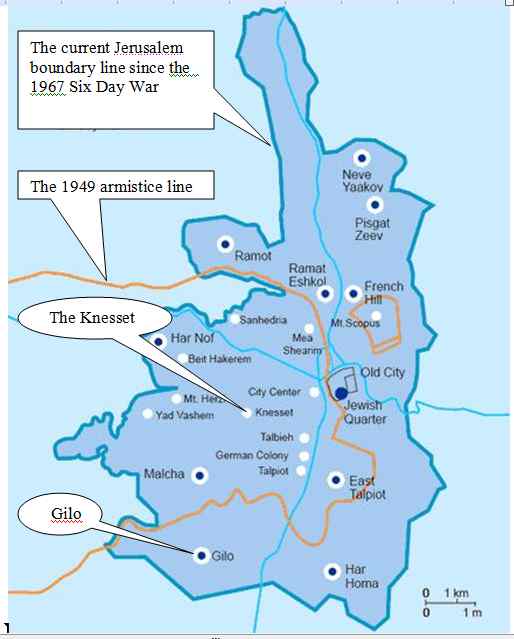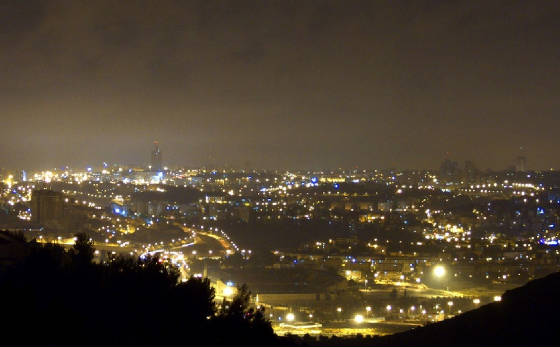|
|
 |
November 22, 2009
The map shows the location of Gilo in the south west of Jerusalem not far from the Knesset and very close to
the 1949 armistice line


Jerusalem looking north towards the Malcha Mall area (foreground) from the edge of the southernmost neighborhood of Gilo.
Photo by Dave Bender
|
|
|
|
 |
|

November 22, 2009
Obviously, unless parties, who are attempting to communicate with each other, attach the same meaning to
the words they use, their communication cannot possibly be meaningful.
The international brouhaha generated by
the decision to build 900 houses in the Gilo suburb of Jerusalem points to the imperative need to reach a common definition
of the word "settlement" in relation to Israel. The anger expressed by the White House and echoed by the EU and even
China, obviously stems from the impulsive conclusion that Gilo is a settlement, no different from the outposts in remote areas
of the West Bank. To quote the bard, therein lies the rub. The $64,000 question then, is whether Gilo is in fact a
settlement and if so, what type of settlement it is. To all who prefer to analyze a situation before arriving at a conclusion
it is important to look at the facts in context.
The Oxford English dictionary defines a settlement as "Newly
settled tract of country,or a colony, but according to the BBC, a settlement is merely a place where people live; as small
as an individual house or as large as a city. http://tinyurl.com/yd6v93d. "
Since a settlement also refers in law, to reaching agreement by parties to a dispute, one may
hope that agreeing on a commonly acceptable definition of this inflammatory word may possibly contribute to "settlement"
of the Arab-Israel conflict.
The reality is that Gilo is very different than the outposts in the West Bank.
It is not in East Jerusalem as widely reported. It is a Jerusalem neighborhood with a population of around 40,000. The ground
was bought by Jews before WW2 and settled in 1971 in south west Jerusalem opposite Mount Gilo within the municipal borders.
The current building approval was not a deliberately provocative political decision by PM Netanyahu
as reported in some media. The plan was initiated a long time ago by the Israel Land Administration. Since Gilo is an integral
part of the city, the approval was given by Jerusalem's Construction and Planning Committee and, as Jerusalem mayor Nir Barkat
said in a statement released by his office, "Israeli law does not discriminate between Arabs and Jews, or between east
and west of the city. The demand to cease construction just for Jews is illegal, as in the US and any other enlightened place
in the world. The Jerusalem Municipality will continue to enable construction in every part of the city for Jews and Arabs
alike."
Ironically, PM Netanyahu has gone further than any previous Israeli Prime Minister. While continuing
the policy of previous governments in refusing to consider a construction freeze in Jerusalem he unexpectedly did agree to
halt construction in the West Bank during negotiations with the Palestinians. Secretary of State, Hillary Clinton, surprised
the world and angered some, by recognizing Netanyahu's departure from the stance of previous governments and praising his
offer as ''unprecedented''. She was indeed very perceptive in recognizing the extent of Netanyahu's compliance with the demands
of the White House. According to a November 19 report, a cabinet minister told Haaretz that Netanyahu has entirely frozen
building in the settlements. Ever since this government was established in April, not a single tender has been issued or plan
approved, not even in East Jerusalem. And this has been done by a cabinet including ministers considered to be extreme
right wingers like Benny Begin, Moshe Ya'alon, Avigdor Lieberman, Uzi Landau and Eli Yishai. "Yet", the minister said,
"Bibi is getting clobbered, relentlessly".
The Haaretz article continues. "Under [former prime ministers]
Rabin, Barak, Sharon and Olmert, there was a lot more building, and the Americans accepted them warmly. Bibi freezes construction
and he gets clobbered. The authorization given this week in Jerusalem is an entirely formal thing...in his heart he [Netanyahu],
really didn't want this, but in retrospect, what could he have said apart from what he said, that Gilo is a integral part
of Jerusalem and is part of the Israeli consensus?"
In his video message to the November 8, Rabin Rally in
Tel Aviv, President Obama urged Israel to pursue Rabin's legacy. It is therefore relevant to recall that Rabin had no intention
of returning to the 1967 lines. In his last speech to the Knesset on October 5, 1995, Rabin said "The borders of the State
of Israel, during the permanent solution, will be beyond the lines which existed before the Six Day War. We will not return
to the 4 June 1967 lines....First and foremost, united Jerusalem, which will include both Ma'ale Adumim and Givat Ze'ev, as
the capital of Israel, under Israeli sovereignty, while preserving the rights of the members of the other faiths, Christianity
and Islam, to freedom of access and freedom of worship in their holy places, according to the customs of their faiths. Changes
will include the addition of Gush Etzion, Efrat, Beitar, and other communities." The complete speech may be viewed
at http://tinyurl.com/6kzam.
As the Western Wall, Ramat Eshkol, French Hill and Pisgat Zeev, are all beyond the Green
Line, it important to consider its significance realistically. The Green line is not an international border. It refers only
to the 1949 Armistice lines established after the 1948 Arab-Israeli War. Its name is derived from the green ink used to draw
the line on the map. Nor is it fixed, as explained by Justice Stephen M. Schwebel, who spent 19 years as a judge of the International
Court of Justice at The Hague, including three years as President. He wrote "...modifications of the 1949 armistice lines
among those States within former Palestinian territory are lawful (if not necessarily desirable), whether those modifications
are, in Secretary Rogers's words, "insubstantial alterations required for mutual security" or more substantial alterations
- such as recognition of Israeli sovereignty over the whole of Jerusalem.." and in a footnote he added "It should be
added that the armistice agreements of 1949 expressly preserved the territorial claims of all parties and did not purport
to establish definitive boundaries between them".
The Palestinians never had sovereignty over the West Bank
nor East Jerusalem and Justice Schwebel concluded that since Jordan, the prior holder of the West Bank and East Jerusalem
had seized that territory unlawfully in 1948, Israel which subsequently took that territory in the lawful exercise of self-defense
in 1967, has better title to it. For Selected Writings of Stephen M. Schwebel, see http://www.2nd-thoughts.org/id248.htmlJordan's illegal annexation of the West bank and East Jerusalem in 1948 was recognized only by Britain
and Pakistan and Jordan now makes no claim to it. In terms of international law, between 1948 and 1967 this territory was
terra nullius, or "land belonging to no one" over which sovereignty may be acquired through occupation. The concept of terra
nullius is well recognized in international law. For example it has been a major issue in Australian politics and Norway occupied
parts of uninhabited Eastern Greenland in the 1920s on the grounds of terra nullius.
As East Jerusalem came into
Israel's possession in the course of a defensive war, Israel was entitled to annex it and create a united Jerusalem. Consequently,
the Jerusalem City Council has jurisdiction over building approvals for Jewish and Arab resident in any part of the city.
It
is highly relevant that the Oslo Accords do not require any freeze of building activity and even the road map which was never
formally ratified, speaks only of dismantling "outposts" erected since March 2001, a far cry from Gilo, that has been a residential
suburb of Jerusalem since 1971.
In proposing solutions towards achieving two states, co-existing in peace and security,
impractical slogans like evacuate the settlements should be discarded because of their vagueness and replaced by a pragmatic
call for territorial compromise taking the above realities into account.
Recommended reading
International
Law http://www.2nd-thoughts.org/id162.htmlThe Occupation http://www.2nd-thoughts.org/id91.htmlThe Six-Day War & Resolution 242 http://www.2nd-thoughts.org/id127.html
|
 |
|
|
 |
|
|
 |
|
|
|
|
|
|
 |

